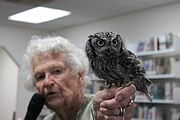The owl lady comes to Othello
OTHELLO — Doris Mager discovered her passion for owls entirely by accident.
“I was working for the Florida Audubon Society — Audubon is about saving birds — in 1963 when someone brought in a bird in a box and said, ‘this is a dangerous bird,’” Mager told a small crowd of children and their parents in the Mid-Columbia Library Branch in Othello on Tuesday.
“It was on its back, it had its talons striking out. It was sick and hungry and dehydrated,” she said. “I looked into the eye of that bird and something spiritual happened. I said to myself, this is the most beautiful bird I’ve ever seen.”
Mager said she took that bird — a red-tailed hawk — home, treated its wounds, nursed it back to health, and set it free after it had recovered.
“It rousted its feather, and off it took, just as if it knew where it was going,” she said. “So, I went back to the Audubon Society and said, ‘If no one cares, I’ll take care of the birds of prey.’”
“And guess what?” Megar said. “No one cared.”
So Meger, still going at 91, has been caring for raptors — eagles, hawks, falcons, owls, and even vultures — for over 50 years now, first with the Audubon Society and Florida and then for her own organization, Save Our American Raptors (S.O.A.R.), where she cared for injured eagles in North Carolina.
She relocated to Kennewick last year to be closer to family. But she’s here in Othello as part of a tour of the entire Mid-Columbia Library system, showing off her owls to kids and adults alike.
“This is E.T., he’s a great horned owl, and he’s 34 years old,” Mager said of the large, rust and gray colored bird perched next to her. “I’ve had her since she was an owlet.”
Owls are important, Mager said, because they eat mice, rats, squirrels, and other troublesome pests. Though the great horned owl prefers to eat skunks, she added.
Mager asked the kids to feel the bones in their necks. Humans have seven, she said, while owls have 14. That’s why they can turn their heads all the way around. Which is something they need to do in order to see, because owls cannot move their eyes and have no peripheral vision.
They also have astounding hearing — they can hear a mouse scurry from 50 feet.
“Their wings make no noise when they fly,” Mager said.
Which is true. There was no swoosh when E.T. leapt off the glove of volunteer Marin Orozco and flew across the room several times.
“At first, I was like, let’s do this, but then I started getting a bit nervous. What if something goes wrong?” Orozco said afterwards.
“It was heavy,” Orozco’s 9-year-old daughter Mariana said after getting to let E.T. perch on her arm.
Mager also brought out a small, gray 10-year-old screech owl missing half a wing named Impy that Mager said she rescued in Texas. Had any more of the animal’s wing been missing, Mager said federal law — she is a federally licensed owl handler — would have required destroying the animal.
Connie Field, director of the Mid-Columbia Library branch in Othello, said that the library has been sponsoring activities and presentations all summer.
“We don’t do this every week, but most weeks, and these are geared for pre-schoolers,” she said.
As she was packing up, Mager said she will continue to give talks on wildlife for as long as she can.
“I never will retire. The U.S. Fish and Wildlife Service won’t let you retire. I give talks all across the U.S.,” she said. “To let these kids (see) these birds and how important they are.”





